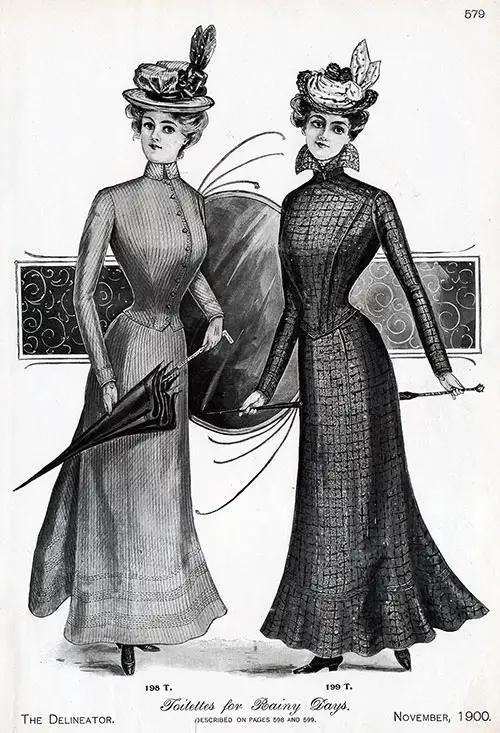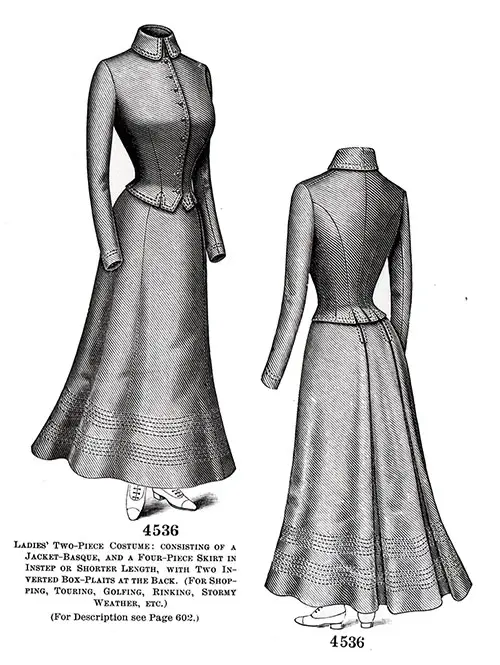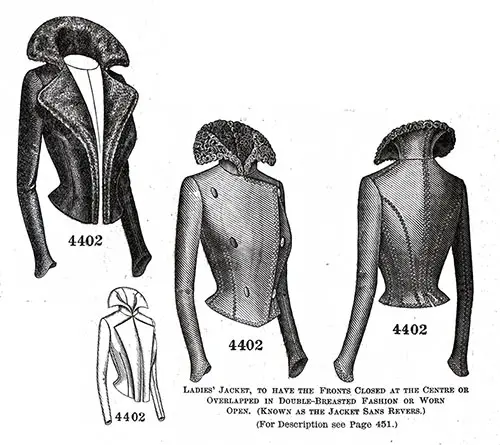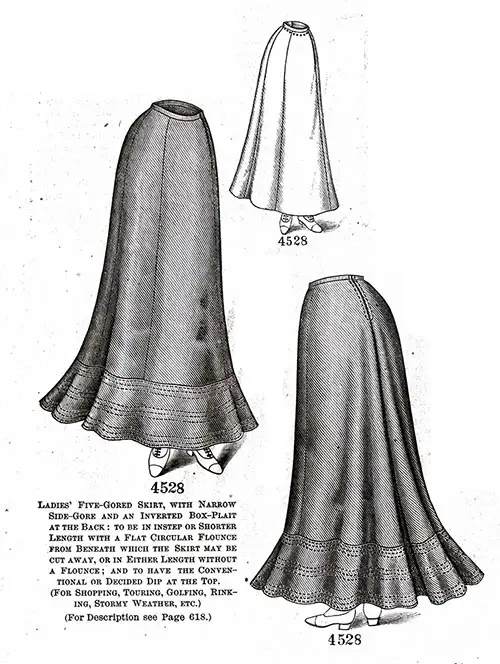Ladies Two-Piece Costumes for Rainy Days - 1900

Ladies' Two-Piece Costume No. 198 T
This represents a Ladies' costume and is pictured on page 579.
The well-dressed woman bestows as much attention nowadays to the fit and finish of her rainy-day costume as to her more elaborate gowns.
Costumes of this style are called hygienic because of their shortened skirt, and they are as suitable for golfing, touring, and ice skating, as for stormy weather and general wear. The one here illustrated is made of striped suiting with stitching for the finish.
The skirt is a four-piece mode and may be in instep or shorter length and has two inverted box-plaits at the back.
The jacket-basque is accurately adjusted, the bust darts and side-back seams ending to form small vents.
The sleeves are close-fitting, in two-seam style, and the basque is prettily notched below the closing, which is mane at the center. A high turn-down collar gives neck completion, and the long shoulder effect is strongly emphasized.
Dressmaker Options
In gray homespun or waterproof cloth, the costume will be serviceable as well as attractive, with stitched strappings of the material or rows of braid for trimming.
Pattern Information
The pattern, which is No. 4536 and costs 1s. or 30 cents, is in nine sizes for ladies from thirty to forty-six inches, bust measure, and is again shown on page 591.
Ladies' Two-Piece Costume No. 4536

No. 4536 Ladies' Two-Piece Costume: consisting of a Jacket-Basque, and a Four-Piece Skirt in Instep or Shorter Length, with Two Inverted Box-Plaits at the Back. (For Shopping, Touring, Golfing, Ice Skating, Stormy Weather, etc.) (For Description see Page 602.)
Description
This hygienic costume is illustrated on page 591, and in figure No. 198 T in this number of The Delineator.
The association of a jacket-Basque and a four-piece skirt result in a very stylish as well as practical costume. The present development shows gray homespun, with rows of machine-stitching for the finish.
The skirt includes four gores, is fitted over the hips by darts and has the fulness at the back disposed of in two inverted box-plaits that are stitched for a short distance from the top.
It may be made in instep or shorter length and ripples attractively at the lower edge, where, in the medium sizes, it measures about three yards and one-fourth.
The jacket-Basque is snugly adjusted, the bust darts and side-back seams ending to form vents. The closing is made at the center, and the Basque is notched at the lower edge in front.
A standing collar having a deep turn-over part gives neck completion, and the closely adjusted two-seam sleeves are finished in cuff effect with stitching. The long shoulder and Juno bust effects are emphasized in this mode, as well as the fashionable Marie Antoinette dip in the skirt.
Dressmaker Options
For shopping, golfing, rainy-day, and general outing wear, the costume is most satisfactory when developed in Cheviot, English Oxford, tweed, double-faced cloth, covert, and waterproof cloth of any preferred color, the darker colors being more useful for general wear.
Pattern Information
We have pattern No. 4536 in nine sizes for ladies from thirty to forty-six inches, bust measure.
For a lady of medium size, the costume needs four yards of material fifty-four inches wide.
Price of pattern, 1s. or 30 cents.
Ladies' Ensemble Outfit No. 199 T

This combines a Ladies' jacket and skirt and is illustrated on page 579.
A trim, short jacket and a five-gored hygienic skirt that may be in instep or shorter length are successfully united in this outfit. The material selected for the development was mixed cheviot, with stitched strappings for the finish.
The jacket, which suggests a point at the lower edge in front and is fitted snugly at the sides and back, closes diagonally but may be worn open if desired.
A high flare collar is at the neck, and the closely adjusted two-seam sleeves are finished in cuff effect with strappings. The five-gored skirt has a narrow side-gore and is distinguished by a flat circular flounce from beneath which the skirt may be cut away.
The flounce gives desirable fulness around the lower edge, but its use is a matter of taste. The mode, which closes at the left side-front seam has an inverted box-plait at the back in habit style and is desirable for golfing, traveling and other outing wear.
Dressmaker Options
Scotch or English tweed, covert cloth, Venetian, homespun, serge, etc., in suitable colors, are useful fabrics, and braid or stitched strappings are the most approved finish.
The jacket is also suitable for development in fur, velvet, etc. A beautiful golfing outfit for a brunette was fashioned from dark-red serge, with strappings for the finish.
Pattern Information
The jacket pattern, which is No. 4402 and costs 10d. or 20 cents, is in nine sizes for ladies from thirty to forty-six inches, bust measure.
The skirt pattern, which is No. 4528 and costs 9d. or 20 cents, is in nine sizes for ladies from twenty to thirty-six inches, waist measure, and is also shown on page 616.
Ladies’ Jacket 4402

(For Illustrations see Page 443.)
Description
Different developments of this light jacket are shown in figures Nos. 139 T and 158 T in this magazine.
The long effect from shoulder to bust—a prominent feature of the newest jackets—emphasizes the natty top garment here shown made of satin-faced cloth with Persian lamb and in dark velvet combined with chinchilla fur.
The mode is known as the Jacket Sans Revers and reaches to a short distance below the line of the waist; it is adjusted snugly at the back and sides by the regulation seams and gores, the center back seam ending to form a vent.
The fronts have the slightest suggestion of a point at the lower edge and are semi-tight fitting; they may be lapped to the throat and closed in double-breasted style or be worn open and rolled as shown in one of the broad front views or closed only at the throat and rolled as shown in the small illustration.
A high, sectional collar that flares at the throat, gives a becoming touch to the mode, and the closely adjusted sleeves may bell over the hand or be straight-around.
Dressmaker Options
Broadcloth, covert, Venetian, and all suitable tailor cloths may be used in the reproduction of the jacket, with fur for the collar and for facing the fronts.
Hunter's green cloth combined with mink would develop a very stylish as well as a serviceable jacket, and the closing could be carried out with cord loops and olives.
An attractive jacket could be made of dark-brown or black light-weight Melton, and the finish may be plain, or braid or narrow fur bindings may be added.
Pattern Information
We have pattern No. 4402 in nine sizes for ladies from thirty to forty-six inches, bust measure.
To make the jacket for a lady of medium size needs a yard and five-eighths of material fifty-four inches wide.
Price of pattern, 10d. or 20 cents.
Ladies’ Five-Gored Skirt No. 4528

No. 4528 Ladies’ Five-Gored Skirt, with Narrow Side-Gore and an Inverted Box-Plait at the Back: to be in instep or Shorter Length with a Flat Circular Flounce from Beneath which the Skirt may be cut away, or in Either Length without a Flounce; and to have the Conventional or Decided Dip at the Top. (For Shopping, Touring, Golfing, Ice Skating, Stormy Weather, etc.) (For Description see Page 618.)
Description
This skirt is illustrated on page 616, and also in figure No. 199 T in this magazine.
One can never say enough in favor of the shortened skirt, a fashion that is at once practical, comfortable, and hygienic.
The skirt shown is made of Oxford-gray cloth finished with stitching, and the shaping causes it to fit smoothly over the hips without the aid of darts, and at the back, the fullness is taken up in an inverted box-plait.
The side-gores are narrower than those ordinarily seen, and the skirt, which may be made in instep length or shorter, is characterized by a flat circular flounce, from beneath which the skirt may be cut away.
At the top, in front, the approved Marie Antoinette dip, that may be conventional or decided, is seen, and at the lower edge in the medium sizes the skirt measures about three yards, and the flounce about three yards and three-fourths.
The mode is especially desirable for shopping, golfing, touring, ice skating, stormy weather and general outing wear, and the flounce may be used or not.
Dressmaker Options
Double-faced cloth, covert, Venetian, and such fabrics are suitable for skirts of this type. A waterproof cloth will also be serviceable, with stitching or strappings for the finish.
Pattern Information
We have pattern No. 4528 in nine sizes for ladies from twenty to thirty-six inches waist, or thirty-seven to fifty-eight and one-half inches hip.
For a lady of twenty-four inches waist or forty-one inches hip, the skirt with the gores extending beneath the flounce, needs three yards and one-half of goods fifty-four inches wide; the skirt with the gores cut away from beneath the frill, or the skirt without the flounce, two yards and five-eighths of fabric in the same width.
Price of pattern, 9d. or 20 cents.
“Descriptions of Figures in Colors, Tints, Etc., Shown on First Page of Cover and Pages 571 to 591 Inclusive,” in The Delineator: An Illustrated Magazine of Literature and Fashion, Paris-London-New York-Toronto: The Butterick Publishing Co. Ltd., Vol. LXI, No. 5, November 1900, p. 579, 591, 602, 616, 618. Also 443 and 451 (ibid October 1900)
Editor’s Note: Some terminology used in the description of women's clothing during the 1800s and early 1900s has been changed to reflect more modern terms. For example, a women's "Toilette" -- a form of costume or outfit has an entirely different common meaning in the 21st century. Typical terms applied to "toilette" include outfit, ensemble, or costume, depending on context.
Note: We have edited this text to correct grammatical errors and improve word choice to clarify the article for today’s readers. Changes made are typically minor, and we often left passive text “as is.” Those who need to quote the article directly should verify any changes by reviewing the original material.
Vintage Outerwear Fashions
GG Archives
Vintage Outerwear Fashions
- Ladies Outdoor Garment 351 L - 1890
- Ladies Attractive Coat and Skirt 4497 4487 - 1900
- Ladies Outdoor Dress and Long Coat 140 T & 141 T - 1900
- Ladies Very Stylish Eton Jacket 139 T - 1900
- Ladies Afternoon Two-Piece Outfit 208 T - 1900
- Ladies Attractive Calling Outfits 184 T and 185 T - 1900
- Ladies Fashionable Street Outfits 194 T and 195 T - 1900
- Ladies Stylish Outdoor Outfits 192 T & 193 T - 1900
- Ladies Two-Piece Costumes for Rainy Days 198 T and 199 T - 1900
- Ladies and Teens Short & Long Coats No. 7410 & 7383 - 1904
- Ladies Coats and Wraps - 7418 & 7427 - 1904
- Paris Couturiers Have Introduced New Wrap Silhouette - 1919
- Resurgence of Fur Coats and Capes Seen 1922
- Rising Prestige of Knitted Outerwear March 1922
- Supple Silhouette of Fall Outerwear 1922
Vintage Fashion Topics
Updates and Social Media
- Visit our GG Archives Vintage Fashions Facebook Page for the Latest News About the Activities of the Archives.
